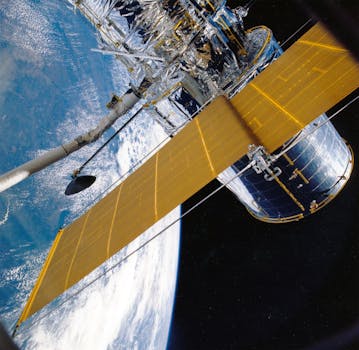The Future of Satellites: Revolutionizing Global Connectivity and Exploration

The Future of Satellites: Revolutionizing Global Connectivity and Exploration. The future of satellites is poised to revolutionize global connectivity and exploration, with advancements in technology and innovation paving the way for a new era in space-based communications and discovery. Satellites have been a crucial part of our daily lives, providing us with navigation, communication, and weather forecasting, among other services. As we move forward, the role of satellites is expected to expand, with new technologies and applications emerging to transform the way we live and work.
One of the most significant advancements in satellite technology is the development of small satellites, also known as smallsats. These satellites are smaller, lighter, and more affordable than traditional satellites, making them an attractive option for startups and researchers. Smallsats have the potential to democratize access to space, enabling more organizations and individuals to launch their own satellites and participate in the global space economy. Companies like Planet Labs and DigitalGlobe are already using smallsats to provide high-resolution imagery and remote sensing data, which has a wide range of applications in fields such as agriculture, environmental monitoring, and disaster response.
Another area of innovation in the satellite industry is the development of satellite constellations. These constellations consist of multiple satellites working together to provide global coverage and continuous connectivity. Companies like SpaceX and OneWeb are launching constellations of thousands of satellites to provide high-speed internet access to remote and underserved communities. This has the potential to bridge the digital divide and provide equal access to information and opportunities for people around the world. Satellite constellations are also being used for other applications, such as navigation, weather forecasting, and Earth observation.
Advancements in Satellite Technology
Advancements in satellite technology are driving the growth and innovation in the industry. One of the key areas of development is in the field of propulsion systems. New propulsion systems, such as electric propulsion and advanced ion engines, are being developed to improve the efficiency and lifespan of satellites. These systems enable satellites to maneuver and maintain their position in orbit, reducing the risk of collisions and extending their operational lifespan. Companies like NASA and the European Space Agency are also investing in the development of new materials and technologies, such as inflatable spacecraft and 3D printing, to reduce the cost and increase the efficiency of satellite manufacturing.
Another area of innovation is in the field of satellite communications. New technologies, such as laser communications and quantum communications, are being developed to provide faster and more secure data transmission. These technologies have the potential to revolutionize the way we communicate, enabling the transfer of large amounts of data quickly and securely. Companies like Google and Microsoft are already investing in the development of these technologies, which could have a wide range of applications in fields such as finance, healthcare, and education.
Challenges and Opportunities
Despite the many opportunities and advancements in the satellite industry, there are also challenges that need to be addressed. One of the main challenges is the issue of space debris. As the number of satellites in orbit increases, so does the risk of collisions and the accumulation of space debris. This poses a significant threat to the safety and sustainability of space operations, and efforts are being made to develop technologies and regulations to mitigate this risk. Companies like SpaceX and OneWeb are working on developing technologies to de-orbit their satellites at the end of their lifespan, reducing the risk of collisions and minimizing the amount of space debris.
Another challenge is the issue of regulation and governance. As the satellite industry grows and becomes more complex, there is a need for clear and effective regulations to ensure the safe and responsible use of space. Governments and international organizations are working together to develop new regulations and guidelines, such as the United Nations Committee on the Peaceful Uses of Outer Space (COPUOS). These regulations will help to ensure that the benefits of space technology are shared equitably and that the risks are minimized.
Conclusion
In conclusion, the future of satellites is poised to revolutionize global connectivity and exploration. With advancements in technology and innovation, the satellite industry is expected to grow and expand, providing new opportunities and applications in a wide range of fields. From small satellites and satellite constellations to advancements in propulsion systems and satellite communications, the industry is driving innovation and pushing the boundaries of what is possible. As we move forward, it is essential to address the challenges and opportunities in the industry, ensuring that the benefits of space technology are shared equitably and that the risks are minimized.




